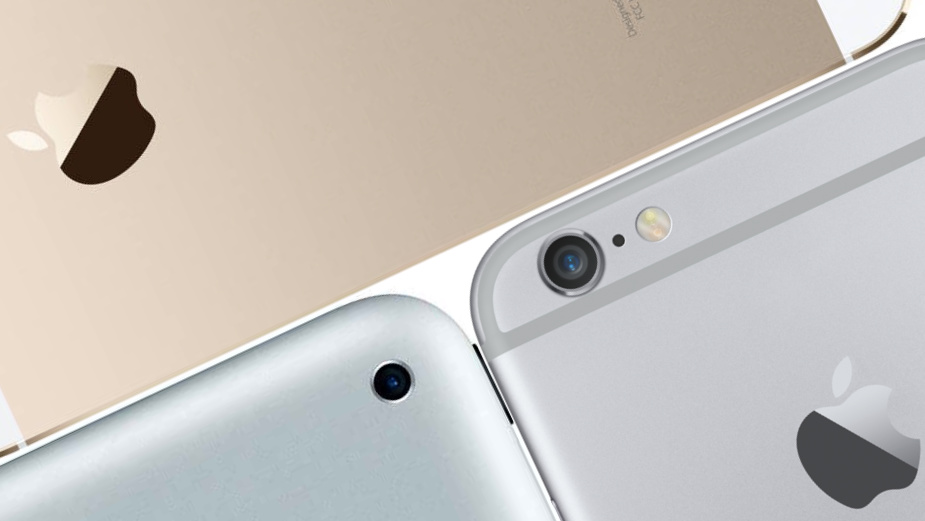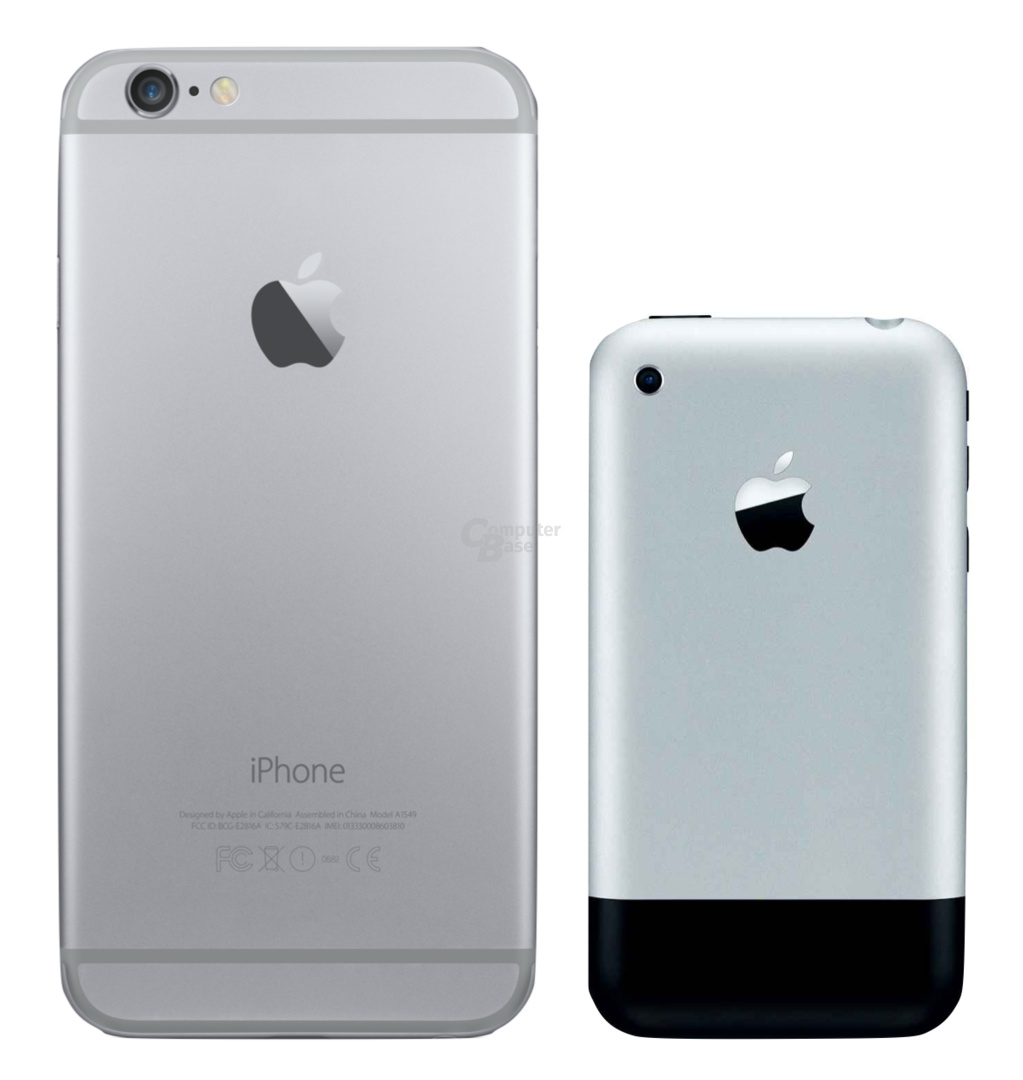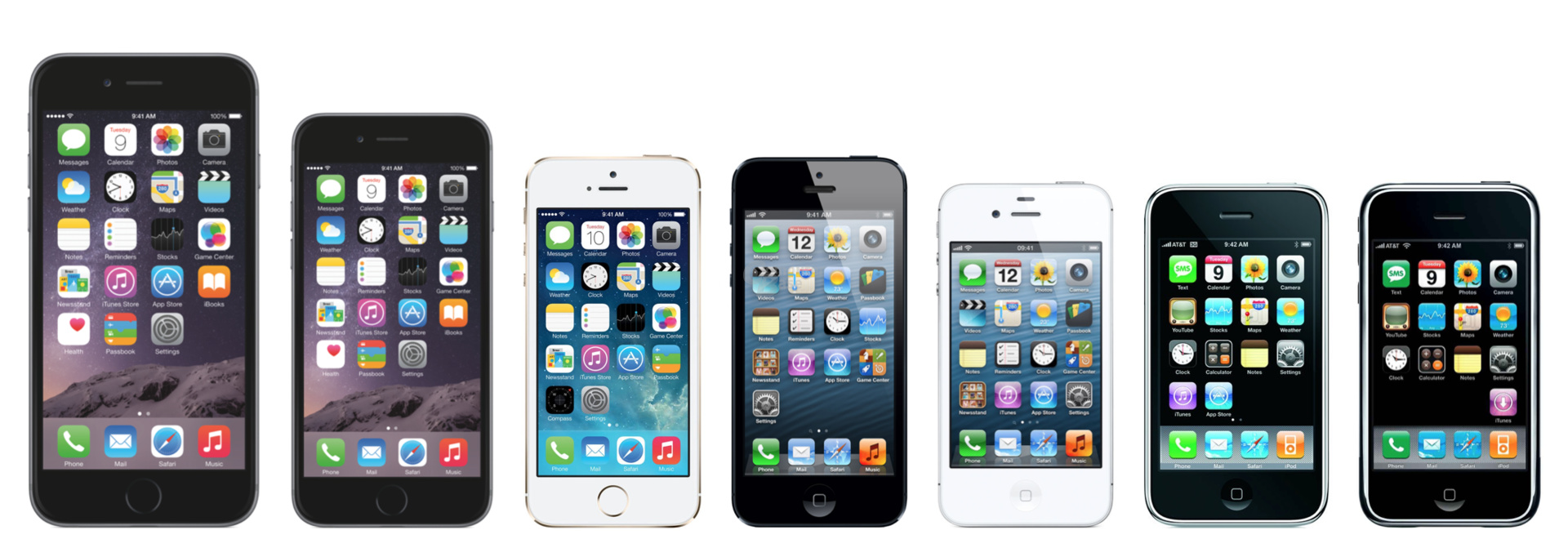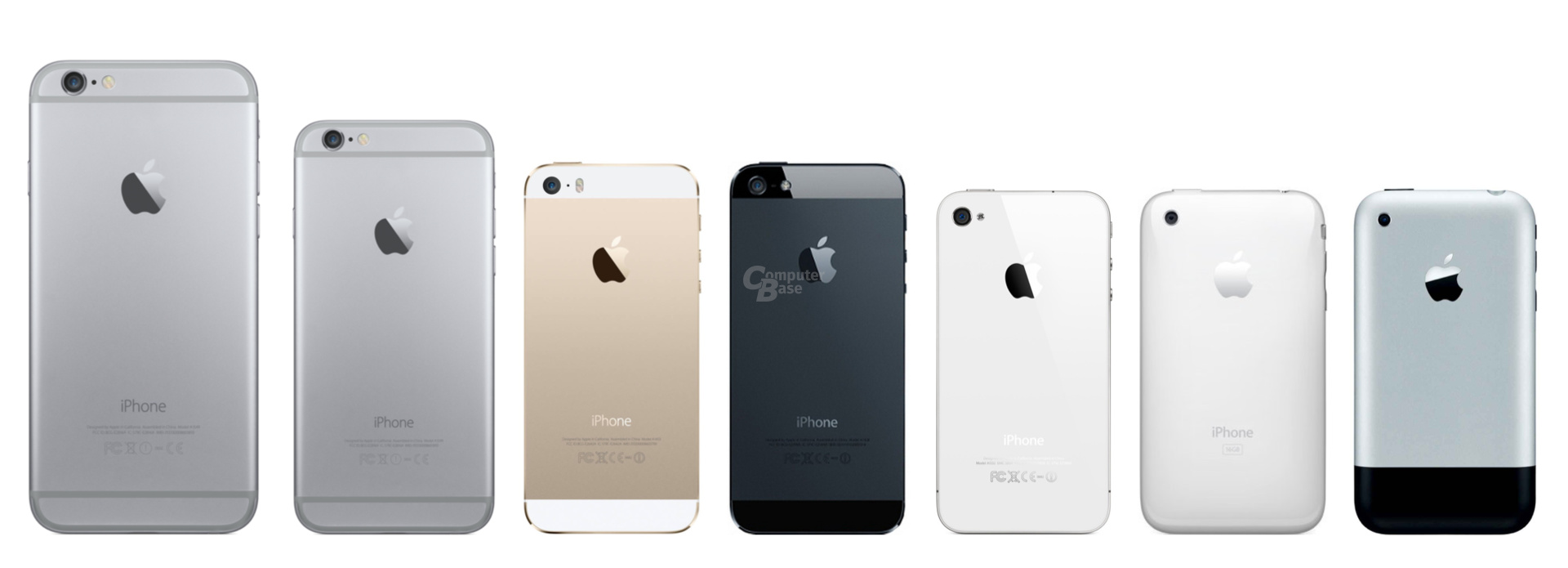iPhone 6 (Plus): iPhone 6, 5S, 5, 4S, 4, 3GS, 3G und 1 im Vergleich

Apple hat das iPhone 6 mit 4,7 und das iPhone 6 Plus mit 5,5 Zoll vorgestellt. Zum zweiten Mal wächst der Bildschirm des Smartphones, zum vierten Mal ändert sich das Aussehen. ComputerBase hat die technischen Daten und Designs aller seit dem Jahr 2007 erschienenen Flaggschiff-iPhone gegenüber gestellt.
iPhone 6 und iPhone 6 Plus sind die bisher größten, aber auch die bis dato dünnsten Smartphones von Apple. Die Neulinge sind nur 6,9 respektive 7,1 mm dick. Gegenüber dem ersten iPhone hat die Bildschirmdiagonale beim großen „Plus“ dafür um 2,0 Zoll zugelegt, beim kleineren Modell sind es immer noch 1,2 Zoll. Beim Gewicht bleibt das iPhone 6 mit 129 Gramm unter dem Gewicht aller Modelle bis zum iPhone 5 und 5S, das iPhone 6 Plus ist mit 172 Gramm hingegen das schwerste iPhone aller Zeiten.

Nach den kantigen Designs von iPhone 4/4S und iPhone 5/5S kehrt das iPhone 6 zur runden Designsprache des Urmodells zurück. So rund wie das iPhone 3G/3GS ist das iPhone 6 allerdings nicht, denn die Rückseite an sich ist eben.

Das Seitenverhältnis bleibt nach einer Anpassung mit dem iPhone 5 bei beiden neuen iPhone mit 16:9 unangetastet – alte Applikationen lassen sich so bildschirmfüllend skalieren. Die höchste Pixeldichte bietet mit 401 ppi trotz größerer Diagonale das iPhone 6 Plus mit Full-HD-Auflösung. Das iPhone 6 bietet mit 326 ppi die doppelte Pixeldichte wie das Urmodell. Für beide Modelle verspricht Apple ein deutlich höheres Kontrastverhältnis.
Wie die Vorgänger setzt auch das iPhone 6 nicht auf Saphirglas, dieses Material ist der Apple Watch vorbehalten. Apple spricht allerdings von einer „mittels Ionen gehärteten Oberfläche“.

Um den An-/Ausschalter trotz größerer Abmessungen weiterhin mit einer Hand zugänglich zu machen, hat Apple den Knopf erstmals an die Seite des Smartphones verlegt. Und auch die Kamera zeigt eine gravierende Veränderung, die schon im Vorfeld der offiziellen Produktvorstellung viel diskutiert wurde: Die Optik ragt aus dem dünnen Gehäuse hervor. Das ist bisher nur vom iPod touch bekannt. Eine Premiere ist der optische Bildstabilisator, zum Einsatz kommt er allerdings nur im iPhone 6 Plus.

Das iPhone 6 ist nicht nur größer, es speichert optional auch mehr Daten. Erstmals haben Kunden die Möglichkeit, das Smartphone auch mit 128 GB Speicher zu bestellen. Die Kamera fotografiert immer noch mit acht Megapixel, die Optik bietet die gleiche Blende. Der Autofokus soll allerdings doppelt so schnell arbeiten.
| 8 GB | 16 GB | 32 GB | 64 GB | 128 GB | |
|---|---|---|---|---|---|
| iPhone 6 | – | 699 Euro | – | 799 Euro | 899 Euro |
| iPhone 6 Plus | – | 799 Euro | – | 899 Euro | 999 Euro |
| iPhone 5S | – | 599 Euro | 649 Euro | – | – |
| iPhone 5C | 399 Euro | – | – | – | – |
Das iPhone 6 Plus ist das teuerste iPhone, das es je gab. Es kostet jeweils 100 Euro mehr als das iPhone 6, das wiederum die Preispunkte des iPhone 5S übernimmt.
| Apple iPhone 6 Plus | Apple iPhone 6 | Apple iPhone 5s | Apple iPhone 5 | Apple iPhone 4s | Apple iPhone 4 | Apple iPhone 3GS | Apple iPhone 3G | Apple iPhone 1 | |
|---|---|---|---|---|---|---|---|---|---|
| Software: (bei Erscheinen) |
iOS 8 | iOS 7 | iOS 6 | iOS 5 | iOS 4 | iPhone OS 3.0 | iPhone OS 2.0 | iPhone OS 1.0 | |
| Display: | 5,50 Zoll, 1.080 × 1.920 401 ppi IPS, Ion-X Glass |
4,70 Zoll, 750 × 1.334 326 ppi IPS, Ion-X Glass |
4,00 Zoll, 640 × 1.136 326 ppi IPS |
3,50 Zoll, 640 × 960 330 ppi IPS |
3,50 Zoll, 320 × 480 165 ppi TN |
||||
| Bedienung: | Touch, Fingerabdrucksensor | Touch | |||||||
| SoC: | Apple A8 2 × Typhoon, 1,40 GHz 20 nm, 64-Bit |
Apple A7 2 × Cyclone, 1,30 GHz 28 nm, 64-Bit |
Apple A6 2 × Swift, 1,30 GHz 32 nm, 32-Bit |
Apple A5 2 × Cortex-A9, 0,80 GHz 45 nm, 32-Bit |
Apple A4 1 × Cortex-A8, 0,80 GHz 45 nm, 32-Bit |
Samsung S5L8920 1 × Cortex-A8, 0,60 GHz 65 nm, 32-Bit |
Samsung S5L8900 1 × ARM11, 0,41 GHz 90 nm, 32-Bit |
||
| GPU: | PowerVR GX6450 450 MHz |
PowerVR G6430 450 MHz |
PowerVR SGX543 MP3 266 MHz |
PowerVR SGX543 MP2 200 MHz |
PowerVR SGX535 200 MHz |
PowerVR SGX535 150 MHz |
PowerVR MBX Lite 3D 103 MHz |
||
| RAM: | 1.024 MB LPDDR3 |
1.024 MB LPDDR2 |
512 MB LPDDR2 |
512 MB LPDDR |
256 MB LPDDR |
128 MB LPDDR |
|||
| Speicher: | 16 / 64 / 128 GB | 16 / 32 / 64 GB | 8 / 16 / 32 / 64 GB | 8 / 16 / 32 GB | 8 / 16 GB | 4 / 8 / 16 GB | |||
| 1. Kamera: | 8,0 MP, 1080p f/2,20, AF, OIS, Dual-LED |
8,0 MP, 1080p f/2,20, AF, Dual-LED |
8,0 MP, 1080p f/2,40, AF, LED |
5,0 MP, 720p f/2,80, AF, LED |
3,0 MP, 480p f/2,80, AF |
2,0 MP f/2,80 |
|||
| 2. Kamera: | Nein | ||||||||
| 3. Kamera: | Nein | ||||||||
| 4. Kamera: | Nein | ||||||||
| 5. Kamera: | Nein | ||||||||
| 1. Frontkamera: | 1,2 MP, 720p f/2,20, AF |
1,2 MP, 720p f/2,40, AF |
0,3 MP, 480p | Nein | |||||
| 2. Frontkamera: | Nein | ||||||||
| GSM: | GPRS + EDGE | ||||||||
| UMTS: | DC-HSPA ↓42,2 ↑5,76 Mbit/s |
Ja ↓14,4 ↑5,76 Mbit/s |
Ja ↓7,2 ↑5,76 Mbit/s |
Ja ↓7,2 ↑0,38 Mbit/s |
Ja ↓3,6 |
Nein | |||
| LTE: | Ja ↓150 ↑50 Mbit/s |
Ja ↓100 ↑50 Mbit/s |
Nein | ||||||
| 5G: | Nein | ||||||||
| WLAN: | 802.11 a/b/g/n/ac | 802.11 a/b/g/n | 802.11 b/g/n | 802.11 b/g | |||||
| Bluetooth: | 4.0 LE | 4.0 | 2.1 | 2.0 | |||||
| Ortung: | A-GPS, GLONASS | A-GPS | Nein | ||||||
| Weitere Standards: | Lightning, NFC, 3,5-mm-Klinke | Lightning, 3,5-mm-Klinke | 30-Pin Dock Connector, 3,5-mm-Klinke | ||||||
| SIM-Karte: | Nano-SIM | Micro-SIM | Mini-SIM | ||||||
| Akku: | 2.915 mAh (11,10 Wh) fest verbaut |
1.810 mAh (6,91 Wh) fest verbaut |
1.560 mAh (5,92 Wh) fest verbaut |
1.440 mAh (5,45 Wh) fest verbaut |
1.432 mAh (5,30 Wh) fest verbaut |
1.420 mAh (5,25 Wh) fest verbaut |
1.219 mAh (4,51 Wh) fest verbaut |
1.150 mAh (4,12 Wh) fest verbaut |
1.400 mAh (5,18 Wh) fest verbaut |
| Größe (B×H×T): | 77,8 × 158,1 × 7,10 mm | 67,0 × 138,1 × 6,90 mm | 58,6 × 123,8 × 7,60 mm | 58,6 × 115,2 × 9,30 mm | 62,1 × 115,5 × 12,30 mm | 61,0 × 115,0 × 11,60 mm | |||
| Schutzart: | – | ||||||||
| Gewicht: | 172 g | 129 g | 112 g | 140 g | 137 g | 135 g | 133 g | 135 g | |
| Preis: | 799 € / 899 € / 999 € | 699 € / 799 € / 899 € | 699 € / 799 € / 899 € | – | |||||
